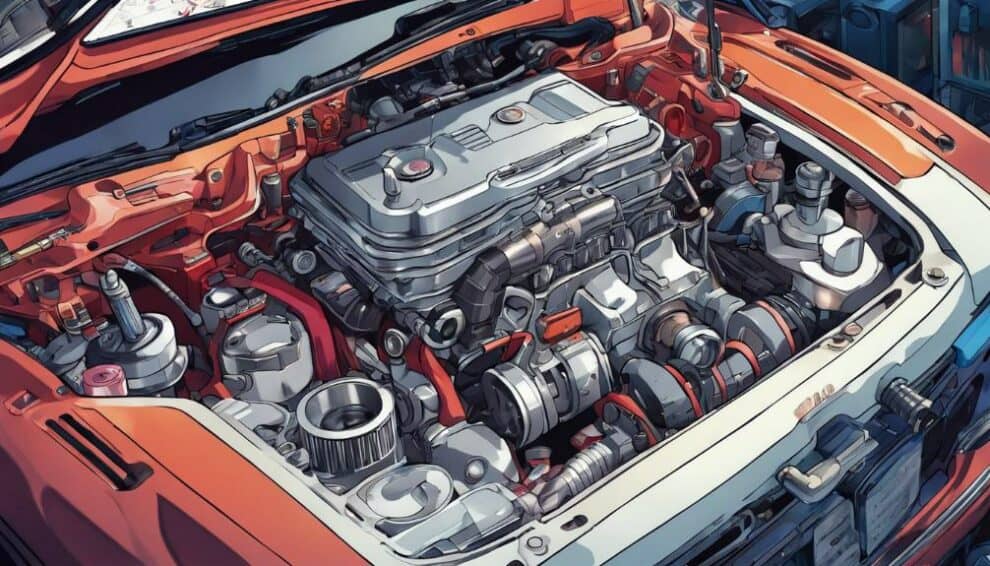When the engine light in your vehicle turns on with a P0401 code, it flags an issue within your car's exhaust gas recirculation (EGR) system. Specifically, it means there's not enough flow in the EGR system.
The EGR is crucial because it helps reduce emissions by recirculating a portion of your exhaust gases back into the engine combustion chamber. An insufficient flow can lead to increased emissions, poor performance, and even engine damage over time.
So, when this code pops up, it's hinting that something's amiss with the EGR flow, but what exactly could be causing this? Let's dive into figuring out why your car might be giving you this signal.
Understanding the P0401 Trouble Code
When diagnosing the P0401 trouble code in your vehicle, it indicates that the Exhaust Gas Recirculation (EGR) system is detecting insufficient flow. The EGR system is designed to reduce harmful nitrogen oxide emissions by recirculating a portion of the exhaust gases back into the engine's cylinders. This process helps lower combustion temperatures, reducing the formation of nitrogen oxides. However, the EGR system has its limitations. It can sometimes lead to carbon buildup in the system, affecting its efficiency.
Understanding the impact of the EGR system on engine performance is crucial. While the EGR system benefits the environment by reducing emissions, it can also impact engine performance. Insufficient EGR flow can cause a decrease in fuel efficiency, rough idling, and even engine hesitation. It's essential to address the P0401 trouble code promptly to ensure optimal engine performance and reduce emissions. Regular maintenance and periodic checks of the EGR system can help prevent issues related to insufficient flow.
Common Causes of EGR Flow Insufficiency
One of the primary reasons for EGR flow insufficiency in vehicles is often attributed to carbon deposits clogging the system's passages. These deposits can accumulate over time, restricting the flow of exhaust gases and impacting the overall performance of the EGR system. In addition to carbon buildup, other common causes of EGR flow insufficiency include faulty EGR valves, damaged EGR coolers, and vacuum leaks in the EGR system.
To help maintain optimal EGR system performance, regular cleaning and inspection are essential. Here are some EGR maintenance tips to consider:
- Check and clean EGR components regularly: Inspect the EGR valve, cooler, and passages for any signs of buildup or damage.
- Use high-quality fuel and additives: Quality fuel can help reduce carbon deposits in the system.
- Perform regular engine tune-ups: Properly tuned engines are less likely to experience EGR flow issues.
- Consider EGR system upgrades: Upgrading to a more efficient EGR system can improve overall performance and reduce the likelihood of flow insufficiency.
| EGR Maintenance Tips | EGR System Upgrades |
|---|---|
| Check and clean EGR components regularly | Upgrade to a more efficient EGR system |
| Use high-quality fuel and additives | |
| Perform regular engine tune-ups | |
Symptoms of a Faulty EGR System
If your vehicle is exhibiting symptoms of a faulty EGR system, you may notice a decrease in engine performance and increased emissions. Here are some key indicators that your EGR system may be malfunctioning:
- Decreased Engine Performance: You might experience a reduction in power output, rough idling, or hesitation during acceleration. These issues can affect your driving experience and may lead to potential safety concerns.
- Increased Emissions: A faulty EGR system can result in higher levels of harmful emissions being released into the environment. Not only does this contribute to pollution, but it may also lead to your vehicle failing emissions tests.
- Poor Fuel Economy: A malfunctioning EGR system can impact your fuel efficiency, causing you to spend more on gas than usual. Monitoring your fuel consumption can help you detect any abnormal changes that could be linked to EGR problems.
To prevent these symptoms and maintain a healthy EGR system, regular maintenance is crucial. Stay tuned for the upcoming section on 'Maintenance Tips for Your EGR System'.
Diagnosing and Testing EGR Components
To diagnose and test EGR components effectively, start by ensuring the vehicle is turned off and the engine has cooled down. Begin by visually inspecting the EGR valve and associated tubing for any signs of damage or clogging.
Next, conduct testing procedures by using a multimeter to check the electrical resistance of the EGR valve solenoid. This can help determine if the solenoid is functioning within the manufacturer's specifications. Additionally, utilize a vacuum pump to apply vacuum to the EGR valve and observe if it opens and closes properly.
Troubleshooting techniques involve checking for carbon buildup inside the EGR valve and passages, which can restrict flow. Use a borescope to inspect these areas effectively. Furthermore, verify that the EGR temperature sensor is providing accurate readings by testing it with a digital multimeter.
If issues persist, consider performing a smoke test to detect any leaks in the EGR system. By following these testing procedures and troubleshooting techniques diligently, you can pinpoint the root cause of EGR flow issues accurately.
Remedies for Resolving EGR Flow Issues
When addressing EGR flow issues, prioritize cleaning the EGR valve and passages to remove any carbon buildup that may be impeding proper flow. Regular maintenance is crucial in ensuring optimal EGR system performance.
Here are some maintenance tips to help you resolve EGR flow issues effectively:
- Inspect and Clean EGR Valve: Regularly inspect the EGR valve for any signs of carbon deposits or sticking. Use an appropriate cleaner to remove buildup and ensure smooth operation.
- Check EGR Passages: Ensure that the EGR passages are free from any blockages or restrictions. Use a specialized tool to clean out any debris that may hinder the flow of exhaust gases.
- Consider Performance Upgrades: Upgrading to a high-flow EGR valve or installing an EGR cooler can improve the efficiency and performance of your EGR system, reducing the likelihood of flow issues in the future.
As an Amazon Associate we earn from qualifying purchases.








